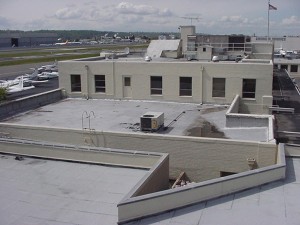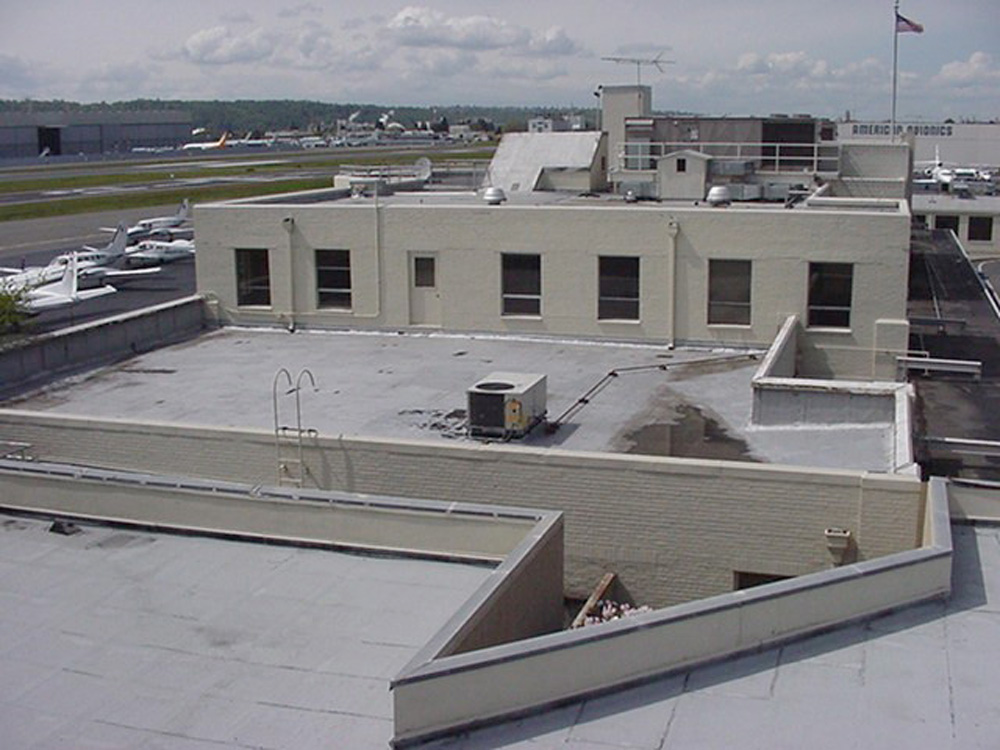
BEFORE: The terminal building roof of King County International Airport / Boeing Field before the grass was planted to assist in insulating the building.
By Jack Elliott
Many major business aviation airports across the country are investing time and funding to cut energy costs and reduce air pollution. They are setting the new industry standard for “being green” by employing some exciting and revolutionary methods.
King County International Airport/Boeing Field
One of the nation’s most innovative airport “greening” projects has transformed King County International Airport/Boeing Field in Seattle, Wash. The flat roof of the airport’s terminal building inspired them to seed it with grass, which now acts as a very effective insulator while greening in a most aesthetically pleasing fashion. At the same time grass was planted on the terminal building roof, the airport switched from electric air conditioning units to more fuel-efficient gas ones.
King County Airport/Boeing Field also demolished two of its oldest airport buildings that were not energy efficient. When the main terminal building, which dated back to 1928, was refurbished back in 2003, the project was completed in compliance with special government guidelines. All of this contributed to the airport’s LEED certification.
LEED (Leadership in Environmental and Energy Design) is a government-sponsored program that establishes greening standards for both new construction and the rehabilitation of existing structures. The program is based on a point system. Points are awarded for compliance with various LEED standards such as site development, storm water system design, energy performance, refrigeration management, water-efficient landscaping, etc. LEED is associated with the United States Green Building Council, which promotes energy efficiency and the reduction of negative environmental impacts.
LEED has several levels of compliance based on its point system. The basic level is certification. There are three higher levels—silver, gold and platinum. Those involved in building or renovating structures use LEED as a guide to the most energy-saving and environmentally friendly procedures.

AFTER: With a fresh coat of bright paint and a lush, green roof, King Count’s terminal building is a visual representation of the airport’s enthusiasm for being friendly to the environment.
The King County Airport/Boeing Field employs many fleet green practices as well, including environmentally safe brake and parts cleaner and fleet replacements with ethanol-based vehicles. New diesel trucks meet current EPA emissions ratings (tier 3), and patrol and fire trucks are equipped with energy-efficient LED lights. Other eco-friendly changes made by the airport include the installation of an energy management system for heating and ventilation and an auto lighting system for both exterior and interior lights. The suitable soil (about 85 percent) excavated during the recent repaving of Taxiway Bravo will be re-used during future developments. The runoff from deicing and washing pads are routed to sanitary sewers instead of storm sewers.
John Wayne Airport, Orange County
At John Wayne Airport, Orange County, in Santa Ana, Calif., the airport’s taxi fleet runs on 100 percent compressed natural gas. Airport police use two segways and one T3 personal transporter. These are zero-emissions vehicles that operate on rechargeable lithium batteries.
The airport’s water conservation program called for the installation of automatic sink faucets, low-flush toilets and water-saving urinals. There is a policy of zero discharge into the storm drain system. The airport recycles 39 percent of recyclable materials and plans to increase that number to 50 percent by 2009.
Ft. Lauderdale Executive Airport
Florida’s Ft. Lauderdale Executive Airport is designing a new 7,200-sq.-ft. facility to house operational equipment and maintenance and security personnel. LEED guidelines will be followed closely during the development of building blueprints. It is estimated that the new facility will be between 10 and 20 percent more energy efficient than the building it’s replacing.
Annually, the airport contributes approximately 20 tons of glass, plastic, aluminum, steel and glass products to the city’s recycling program. It also encourages conference calls to conduct business rather than driving to meetings, which keeps vehicles off the road and reduces emissions.
By using low-energy light bulbs and automatic thermostats in the administration building, the airport has reduced energy consumption by at least 10 percent each year. It expects to save about $18,000 each year in electricity and reduced maintenance costs by installing more than 250 energy-efficient LED taxiway lights during its Taxiway Alpha relocation project.
The administration building uses only low-energy bulbs, and all the thermostats are set on timers to reduce the temperature during non-working hours. One of the airport’s tenants, Kaplan University—which operates from a new four-story, 100,000-sq.-ft. office and administration building—employs an unusual energy-saving system. They use sensors along perimeter windows to automatically turn lights on and off according to the amount of natural light.
Orlando Sanford International Airport
Orlando Sanford International Airport, which caters to both commercial and business aircraft (there are 75 business aircraft based at the field), is in the final stages of a $3.5 million upgrade of all facilities. The airport expects to save $450,000 a year in power costs and millions of gallons of water.
They also anticipate a 35 percent reduction in carbon emissions. New insulation, energy-saving bulbs and automatic bathroom facilities bring this airport one step closer to green, along with new controls for heating and air conditioning and an automatic shut-off system for exterior and interior lights. As an employee benefit, Orland Sanford is building a plug-in facility in the employee parking lot, so hybrid drives can power up for free.
Westchester County Airport
Westchester County Airport in White Plains, N.Y., is developing an environmental management system. The FAA has announced that airports with such a system will receive preferential treatment in the awarding of Airport Improvement Program funding.
One measure Westchester County is taking as part of this plan is the replacement of 26 vehicles, including diesel tugs and push-backs, with electric power. A recharging center will be built to service the new vehicles.
One of the airport’s business aviation tenants (who requested not to remain anonymous) is renovating a 50-year-old hangar and is hoping to achieve the LWWS Gold Level. The hangar will have solar panels, and the plants on the roof will reduce heat levels. They will install wind turbines and a water conservation system, among other environmentally friendly initiatives.
Centennial and Deer Valley Airports
In Denver, Colo., at Centennial Airport, milled asphalt from taxiway and runway repairs and resurfacing projects has been used in the construction of an airport perimeter road and access roads.
Another western airport recycling asphalts is Deer Valley Airport in Phoenix, Ariz. The airport also has two environmental waste sites for hazardous items like oil and oil filters, aircraft batteries, tires and chemicals. The airport collects these materials from maintenance staff and tenants (at no cost). A contractor visits the waste sites and disposes materials in accordance with environmentally sound procedures.
Little publicity has been given to these important initiatives, but they are shaping the future of airport operations and neighboring communities. The impact made today will benefit these airports, patrons, employees and the environment for years to come.












